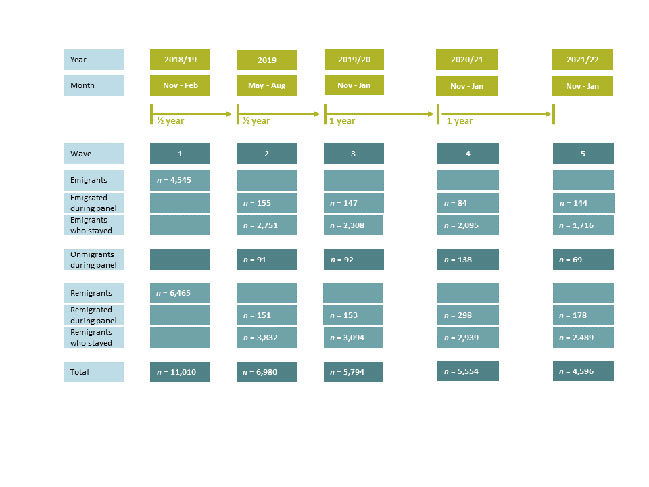Use of cookies
Cookies help us to provide our services. By using our website you agree that we can use cookies. Read more about our Privacy Policy and visit the following link: Privacy Policy
GERPS is a panel study about 20 to 70 years old German citizens who either left Germany or returned from abroad between July 2017 and June 2018. The study currently comprises five waves covering a period of 36 months. The first wave started in November 2018 and ended in February 2019. The corresponding Scientific Use File (SUF) is already accessible. The second wave started in May 2019, six months after the beginning of wave 1. The third wave started in November 2019 and ended in January 2020, six months after the beginning of wave 2. One year after the third wave, we conducted wave 4, which lasted from November 2020 to January 2021. Wave 5 fielded in November 2021, one year after wave 4.
The short intervals of six months between waves 1, 2 and 3 enable a detailed analysis of short-term consequences of international migration. By expanding the interval to twelve months between waves 3, 4 and 5, the aim is to increase observed migration events and to lay the foundation for studying mid-term consequences of international migration.
Over the course of our panel, the mobility patterns of the respondents diversified. The figure below depicts the different migrant groups that emerged. There are participants who left Germany from the second wave on (“Panel emigrants”). In each wave, the largest share of emigrants stayed in the destination where they emigrated to in the previous wave(s) (“Stayer emigrants”). However, we also observed some highly mobile emigrants who moved on to a third destination (“Panel onmigrants”). Some participants also remigrated to Germany after the first wave (“Panel remigrants”). Throughout the panel, a large part of our participants reported to live in Germany since their remigration in a previous wave (“Stayer remigrants”).

![]() GERPS time line and overview of realized interviews per wave
GERPS time line and overview of realized interviews per wave
Each wave covers questions on German migrants’ current situation, gradually enabling researchers to draw a picture of survey participants’ life course with every further wave. Additionally, each wave has its own focus.
The first wave covers questions on participants’ employment situation, their well-being, romantic relationships, migration motives and future migration plans. A special feature are questions about participants’ situation shortly before migration. This enables the realization of a hypothetical additional measurement point, allowing researchers to reflect on causes and consequences of international migration from the very beginning of the survey.
The majority of respondents participated by using computer-assisted web interviews (CAWI). However, wave 1 additionally comprises a split ballot experiment using paper-and-pencil interviews (PAPI) in subsamples. Accordingly, GERPS does not use interviewers for surveying. They are only used for panel maintenance (e.g. updating address information).
Researchers can access the Scientific Use File of wave 1 in the GESIS data archive. The corresponding methodology report documents the survey process in detail. It is part of the “BiB Data and Technical Reports” publication series and can be downloaded on the website of the Federal Institute for Population Research (BiB).
The second wave concentrates on income, labour market integration, and social background. Wave 2 also features many modules from the previous wave, enabling researchers to carry out initial panel analyses.
The SUF of the second wave can also be accessed via the GESIS data archive. Information about pretests, instruments, generated variables as well as standards regarding data processing and weights are provided in the methodology and data manual of wave 2. Just like the wave-1 manual, the manual for wave 2 is freely available on the BiB website.
The third wave covers social and familial relationships in particular. Its SUF has been published together with the second wave and can be accessed via the GESIS data archive. The manual of wave 3 is freely available in the publications section and on the BiB website.
Wave 4 aims at enhancing the longitudinal perspective of GERPS with respect to classical dimensions of social inequality such as employment and income, well-being and life satisfaction, relationship and family, and social relations and social participation. In addition, wave 4 also features new modules on issues like ostracism, ethnic boundaries and on international migration in light of the COVID-19 pandemic.
Wave 5 fielded in November 2021, one year after wave 4. The fifth wave thus expands the panel frame of GERPS to three years. Through including many questions from previous waves, wave 5 increases the surveys’ potential for longitudinal analyses on internationally mobile individuals. However, the latest wave also features new modules on students, political interest, (dual) citizenship, perceptions of cultural differences, and more.